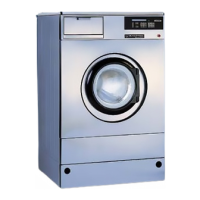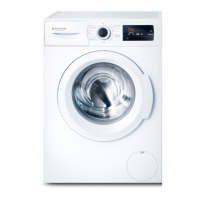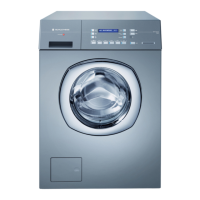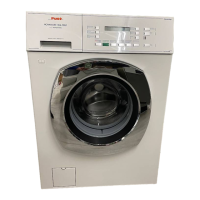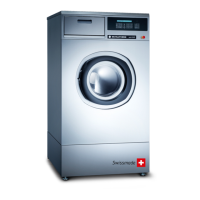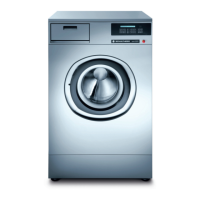Do you have a question about the Schulthess WSI 300 and is the answer not in the manual?
Identifies dangers from incorrect use, non-compliance, or unqualified personnel.
Explains key safety symbols (Warning, Caution, Important) and their meanings.
Defines the machine's approved applications and specifies usage restrictions.
Warns against dry cleaning and storing flammable materials near the machine due to explosion risk.
States the machine's weighted continuous sound intensity level.
Highlights general dangers like explosion hazards, steam release, and slipping risks.
Warns about the hot door glass (up to 82°C) and the risk of burns during operation.
Advises leaving the door ajar after use to ventilate and prevent mildew and odors.
Specifies user age limits and operator responsibilities for safe machine operation.
Instructs immediate action to press the red emergency off switch in critical situations.
Covers machine dimensions, lifting points, and conditions for proper storage.
Provides guidance on unpacking the machine and responsible disposal of packaging materials.
Details the general requirements for installing, leveling, and securing the washing machine.
Specifies the necessary clearance and space needed for the machine's installation location.
Outlines the need for a level and stable supporting surface for optimal machine operation.
Suggests improving working height for staff comfort and safety via bases or options.
Explains the step-by-step process for safely lifting and moving the machine off its pallet.
Guides on safely removing transport safety catches, emphasizing their importance.
Describes two installation methods: using insulating mats without feet, or with adjustable levelling feet.
Covers connecting energy, water, and waste outlets, referring to enclosed plans.
Details requirements for electrical connection by authorized personnel according to regulations.
Explains water connection procedures, including water types and valve block connections.
Describes direct and indirect steam connections and necessary adjustments for steam pressure.
Provides crucial steps and warnings for initial machine startup and cleaning.
Offers an overview of the washing machine's main components and overall design.
Illustrates and labels the key parts of the machine, such as the door and operating panel.
Explains how to open the door at the end of a program and notes it cannot be opened during operation.
Details the procedure for manually opening the door using a screwdriver, with safety precautions.
Introduces the detergent dispenser, its compartments, and usage recommendations.
Shows the layout of detergent beakers and provides important tips for powder and liquid use.
Describes the method for correctly inserting detergent beakers into their designated slots.
Illustrates detergent beakers with markings for powder and liquid filling levels.
Details the standard equipment and optional connections for liquid detergents and water recycling.
Explains the water recycling option, potential savings, and crucial parameterization advice.
Details the information found on the machine's type plate, including model and technical specifications.
Identifies and explains the function of all control panel buttons, indicators, and the text display.
Guides users through selecting standard, commercial, and special programmes.
Explains how to correct a selected programme by cancelling and re-selecting it.
Details how to start, pause, and resume a washing cycle using the Start/Stop button.
Explains the purpose and correct usage of the Emergency Off button for immediate safety stops.
Describes how to delay the start of a programme for up to 99 hours using the preset time function.
Explains how to add extra detergent or rinse aid during a wash cycle.
Details how to adjust the washing temperature downwards using specific controls.
Guides on how to cancel a programme that is currently running.
Describes how the end of a programme is signalled and what message appears.
Explains how the machine's display shows the progress and remaining time of a programme.
Lists standard programmes with recommended detergent beakers and estimated wash times.
Details specific programmes for hospital, home, and hotel laundry operations.
Continues the list of commercial programmes, including express cycles for business use.
Lists programmes designed for wet cleaning of various textiles like outerwear and silk.
Explains how to create and use custom washing programmes via chip cards or direct input.
Details the procedure for transferring programmes from a Wash-Card to the machine.
Describes the activation and use of wet-cleaning programmes, noting detergent compatibility.
Provides general advice on textile care, emphasizing care labels and sorting.
Guides on proper laundry preparation, including emptying pockets and knotting cords.
Specifies maximum dry laundry loads for different machine models and fabric types.
Details the steps for preparing the machine before starting a wash, including water and power.
Explains actions at the end of the cycle, such as switching off power and cleaning.
Lists common error messages, their causes, and recommended solutions for troubleshooting.
Covers additional fault messages like 'Hardware' and their troubleshooting steps.
Provides essential safety and operational guidelines before performing cleaning or maintenance.
Recommends suitable cleaning agents and warns against hazardous or damaging substances.
Outlines a schedule for routine maintenance tasks for operating personnel.
Details specific maintenance procedures for water recycling components.
Provides instructions for safely rendering the machine inoperable and its proper disposal.
| Category | Washer |
|---|---|
| Model | WSI 300 |
| Energy Efficiency Class | A+++ |
| Spin Speed | 1400 rpm |
| Noise Level (Spinning) | 74 dB |
| Dimensions (H x W x D) | 85 x 60 x 60 cm |
| Programs | Cottons, Synthetics, Delicates, Wool, Quick wash |
